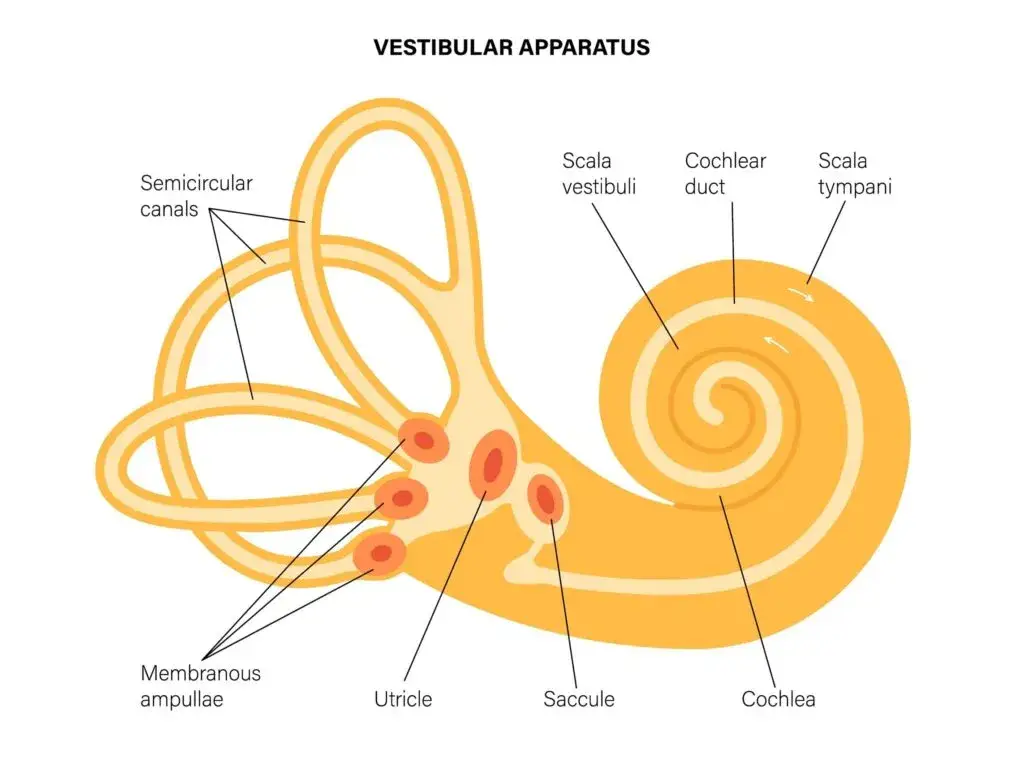
Can Migraine Cause Nausea? If you’ve ever curled up in a dark room during a migraine and thought, “Why do I feel so nauseous?”—you’re not alone. Nausea is one of the most common and frustrating migraine symptoms. For many people in Sarasota, Bradenton, Lakewood Ranch, and across Southwest Florida, the cycle is the same: a throbbing head, sensitivity to light and sound, and a stomach that churns with each wave of pain.
At Lavender Family Chiropractic, we help people every day who are battling migraines with nausea, vomiting, dizziness, and brain fog. As Upper Cervical Chiropractors, our focus is the top of the neck—where the skull meets the spine—and how subtle misalignments in this region can irritate the trigeminocervical nucleus (the neural hub that blends head and neck pain pathways). When this area is irritated, migraines often become more frequent and more intense—and nausea can ride along as an all-too-unwelcome passenger.
This guide explains why migraines so often cause nausea, how a misalignment in the upper neck can inflame that connection, and how precise, gentle Upper Cervical care can address the root cause—without popping, twisting, or cracking. If you’re searching for “chiropractor Sarasota Florida,” “upper cervical chiropractor near me,” “Migraine doctor near me,” or “Vertigo doctor near me,” this is for you.
Can Migraine Cause Nausea? Why Migraines and Nausea Travel Together
Migraines are more than “bad headaches.” They’re complex neurological events that can involve:
- Throbbing or pulsating head pain (often one-sided)
- Nausea and/or vomiting
- Sensitivity to light (photophobia), sound (phonophobia), and sometimes smells (osmophobia)
- Neck pain and stiffness
- Visual, sensory, or speech changes (aura)
- Dizziness, imbalance, or motion sensitivity (vestibular migraine)
- Brain fog, fatigue, and irritability before or after the headache phase
Nausea occurs because migraine isn’t just a pain problem—it’s a brain-stem and autonomic nervous system problem. Deep in the brainstem is an area that helps regulate nausea and vomiting (including the area postrema), along with centers that influence balance, eye movements, and head/neck sensation. During a migraine, signals in these areas become hypersensitive. The gastrointestinal system can slow down, the vagus nerve can misfire, and the body’s “fight or flight” response may spike—setting the stage for queasiness and vomiting.
Meet the Trigeminocervical Nucleus: The Head–Neck Pain Hub
The trigeminocervical nucleus (TCN) sits in the upper spinal cord and lower brainstem. It’s the “switchboard” where sensory information from the face (via the trigeminal nerve) meets input from the upper neck (via the first three cervical nerves, C1–C3).
Why this matters:
- When the upper neck is irritated, the TCN can ramp up.
- A sensitized TCN makes facial/head pain pathways more reactive—fueling migraines.
- Because the TCN neighbors brainstem regions that influence nausea, dizziness, and eye movements, symptoms tend to cluster: headache + neck pain + nausea + light/sound sensitivity + motion sensitivity.
In other words: aggravate the upper neck, and you can accidentally aggravate migraine circuitry—including the pathways that trigger nausea.
How Upper Neck (Upper Cervical) Misalignment Triggers Nausea
The top two neck bones—C1 (atlas) and C2 (axis)—are uniquely shaped to allow your head to move freely. They also cradle and protect the lower brainstem. When these bones shift out of optimal position—sometimes from old injuries, whiplash, poor posture, dental/orthodontic changes, or even birth stress—the result can be:
- Irritation of Upper Cervical Nerves (C1–C3):
These nerves feed into the TCN. Chronic irritation can sensitize migraine pathways, making them fire more easily. - Tension in Suboccipital Muscles and Fascia:
Tightness beneath the skull can tug on dura and influence blood flow and cerebrospinal fluid dynamics—adding fuel to migraine physiology. - Autonomic Nervous System Imbalance:
The upper neck has a direct line into the systems that regulate “fight or flight” and “rest and digest.” Dysregulation can slow digestion, trigger queasiness, and heighten stress responses—classic migraine-nausea drivers. - Vestibular and Eye-Head Coordination Strain:
Subtle misalignment can challenge the balance system and the reflexes that stabilize vision when you move your head. That mismatch in signals is a frequent reason people feel nauseous, motion-sick, or dizzy during migraine episodes.
When you address the upper neck misalignment precisely and gently, you can calm the TCN, balance the autonomic nervous system, and reduce the triggers that cause both migraine and nausea.
Upper Cervical Care: Resolving Migraines and Nausea at the Root
Upper Cervical Chiropractic is a specialized approach that focuses on restoring the precise alignment and motion of the atlas and axis without forceful manipulation. At Lavender Family Chiropractic in Sarasota, we use modern imaging and instrumentation to measure, correct, and monitor your unique alignment.
Here’s what that looks like:
- 3D CBCT Imaging (Cone-Beam CT):
We use state-of-the-art 3D CBCT scans to view the upper cervical joints and surrounding anatomy in remarkable detail. This allows us to detect even subtle misalignments and anatomical nuances that standard X-rays can miss. - Functional Nervous System Scans (Tytron Paraspinal Infrared Thermography):
This noninvasive scan helps assess how your nervous system is functioning along the spine. Patterns of thermal asymmetry can correlate with autonomic imbalance—often seen in migraine sufferers with nausea. - Gentle, Precise Corrections (No Popping, Twisting, or Cracking):
We use a specialized Upper Cervical procedure (including advanced knee-chest technique) tailored to your exact measurements. Corrections are specific and light—designed to reduce irritation around the brainstem and upper cervical nerves. - Post-Adjustment Rest and Re-Checks:
After a correction, you’ll rest (we even have zero-gravity chairs) so your body can integrate the change. We re-scan to confirm improved nervous system balance and stability. - Stability-Focused Care Plans:
The goal is not repeated “cracking” but long-term stability. As your alignment holds longer, the TCN quiets, migraine frequency and intensity often drop, and nausea becomes less frequent and less severe.
Migraine + Nausea: What Improvement Can Feel Like
Every case is unique, but here’s what many of our patients report as we restore upper cervical alignment:
- Fewer “bad days” per month
- Reduced nausea, less reliance on anti-nausea meds, and fewer vomiting episodes
- Less sensitivity to light, sound, motion, and screens
- Better neck comfort and range of motion
- Improved sleep quality and mental clarity
- More energy and confidence to plan life again—without fearing the next migraine
We never promise a cure, and we always respect your existing medical plan. Our goal is to be the “missing piece” that reduces the neurological load driving your migraines and queasy stomach.
Simple, Safe Strategies to Ease Migraine-Related Nausea (While We Work on Alignment)
While we correct the root cause in your neck, small daily choices can help calm nausea:
- Steady Hydration + Electrolytes: Sip water regularly.
- Gentle, Frequent Meals: Avoid long gaps; add protein and healthy fats to steady blood sugar.
- Ginger or Peppermint: Teas or lozenges can soothe the stomach.
- Magnesium and Riboflavin (B2): Commonly used migraine-support nutrients; discuss with your provider.
- Consistent Sleep + Light Morning Sun: Stabilizes circadian rhythms and the autonomic nervous system.
- Breathing and Vestibular Calm: Slow nasal breathing, gentle head/eye movement drills as tolerated.
- Trigger “Stacking” Awareness: A little screen time, a skipped meal, and poor sleep can combine. Guard your margins.
These tips are supportive—not a replacement for medical care. If symptoms are severe or changing, talk to your healthcare provider.
When to Seek Urgent Care
Call 911 or seek emergency care if you experience any “red flag” symptoms: a sudden “worst headache of your life,” new neurological deficits (weakness, facial droop, trouble speaking), fever with stiff neck, head injury, or a dramatic change in your usual migraine pattern.
Our Process at Lavender Family Chiropractic (Sarasota & Manatee County)
- Conversation + History: We listen—when did the migraines and nausea start, what triggers you’ve noticed, and what you’ve already tried.
- Functional Nervous System Scans: Tytron infrared thermography helps us see patterns of autonomic stress.
- Exam: Orthopedic, neurologic, and Upper Cervical-specific testing.
- 3D CBCT: Precision imaging to determine the exact correction vector your atlas/axis require.
- Gentle Correction: Tailored Upper Cervical adjustment—no twisting, popping, or cracking.
- Rest + Re-Scan: Integrate the change and verify improvements.
- Care Plan: We track your progress—headache days, nausea severity, sleep, energy, and function. Our aim is stability, not dependency.
We’ve designed our office to feel calming and hopeful—with a three-doctor team so you’re supported every step: Dr. Rusty Lavender, Dr. Jacob Temple, and Dr. Will Guzinski.
Why People Choose Lavender Family Chiropractic
- Upper Cervical Expertise: Focused care where the head meets the neck.
- Advanced Imaging: 3D CBCT for detail that traditional imaging can miss.
- Objective Scans: Tytron thermography to monitor nervous system changes.
- Gentle Technique: Precise corrections without aggressive manipulation.
- Whole-Person Approach: We coordinate with your medical team and support lifestyle upgrades.
- Local, Trusted, and Accessible: Serving Sarasota, Bradenton, Lakewood Ranch, Parrish, Ellenton, Venice, Osprey, Punta Gorda, St. Petersburg, Siesta Key, Longboat Key, Lido Key, and Myakka City.
If you’ve been searching for “chiropractor near me,” “upper cervical chiropractor near me,” “Migraine doctor near me,” or “Vertigo doctor near me,” we’re here to help you chart a different path.
Patient Snapshot (Illustrative)
“Before I found Lavender Family Chiropractic, I was averaging 10 migraine days a month, with nausea so bad I carried a bag in the car. My neck always felt tight. After my CBCT, they showed me exactly how my atlas was misaligned. The first few weeks, I noticed more good days. Two months in, I’d had only three migraines—none with vomiting. The biggest win: I’m not planning my life around my stomach anymore.”
— J., Lakewood Ranch
Results vary, and we never guarantee outcomes—but stories like J.’s keep us doing what we do.
Top 15 FAQs: Migraines, Nausea, and Upper Cervical Care
- Can migraine really cause nausea?
Yes. Migraine involves brainstem regions that regulate nausea and vomiting. When these areas are activated, queasiness and vomiting can accompany the headache—sometimes even without severe head pain. - Why does my neck hurt during a migraine?
The trigeminocervical nucleus blends head and upper-neck pain signals. Neck tension or misalignment can sensitize this hub, often making neck pain part of the migraine picture. - How could the top of my neck affect my stomach?
The upper neck influences autonomic balance (vagus and sympathetic systems). Dysregulation can slow digestion and heighten nausea—especially during migraine flares. - What is Upper Cervical Chiropractic?
A specialty that focuses on precisely aligning C1 (atlas) and C2 (axis) to reduce irritation near the brainstem. The corrections are specific and gentle—no popping, twisting, or cracking. - Is it safe if I get aura or vestibular migraines?
Yes, Upper Cervical care is gentle and tailored. We screen carefully, coordinate with your medical team as needed, and proceed only when appropriate. - How do you know if my upper neck is misaligned?
We use a detailed exam, functional nervous system scans with Tytron infrared thermography, and 3D CBCT imaging to map your unique alignment and anatomy. - Will one adjustment fix me?
Some people feel relief quickly; others need time for the nervous system to calm and stabilize. Our goal is long-term alignment “holding,” not frequent forceful manipulation. - Can Upper Cervical care help if I’ve had migraines for years?
Chronic cases can still improve. The nervous system remains adaptable. We’ll set clear goals, measure progress, and personalize your plan. - What if medication helps—should I stop?
Never change prescriptions without your prescribing provider. Our role is complementary: reduce the neurological load so you may need fewer “rescue” days over time. - Do you twist or crack the neck?
No. Our corrections are precise and gentle, based on your CBCT measurements. - How soon might nausea improve?
It varies. Some notice fewer or milder waves within weeks; others improve steadily over several months as alignment stabilizes and the TCN calms. - Do you treat kids or teens with migraine?
Yes, when appropriate. We assess each case individually and use age-appropriate, gentle methods. - Will you work with my neurologist or primary care doctor?
Absolutely. We regularly coordinate care, share findings (with your permission), and keep communication transparent. - Do you take insurance?
Our office is out of network with insurance. Many of our patients receive a superbill to submit to their insurance for reimbursement based on their coverage. We offer many different payment options as well as finance options. - How do I get started?
Book a consultation. We’ll review your history, perform scans, and—if appropriate—take 3D CBCT imaging. Then we’ll design a personalized plan to calm migraines at their root.
What to Expect in the First 4–8 Weeks
- Weeks 1–2: Foundational corrections and nervous system “reset.” You might notice changes in neck ease, sleep, or light/sound tolerance. Some people feel “different tired” as the body recalibrates.
- Weeks 3–4: We look for trend lines—fewer severe days, shorter duration, reduced nausea, improved focus.
- Weeks 5–8: Stability becomes the goal. As corrections hold, many patients need fewer visits, and migraine/nausea patterns continue to settle.
We’ll check in on your “metrics that matter”: headache days, nausea frequency/intensity, screen tolerance, sleep, energy, and confidence.
Upper Cervical Care vs. General Chiropractic for Migraines
General chiropractic can help many people with musculoskeletal pain. Upper Cervical care is more specialized and laser-focused on the atlas/axis region and its neurological influence. Rather than adjusting multiple levels routinely, we correct precisely when and where the data say it’s needed, then allow your body to stabilize. Less is more—especially near the brainstem.
If You Also Have Dizziness or Motion Sensitivity
Vestibular migraine often pairs nausea with imbalance and visual motion sensitivity. By improving atlas/axis alignment, we reduce conflicting signals between your neck, eyes, and inner ear—often decreasing motion-induced queasiness. As you stabilize, we can layer simple, tolerable visual–vestibular drills to reinforce progress.
Why 3D CBCT and Tytron Matter for Migraine Sufferers
- CBCT: Shows joint spacing, facet orientation, and anatomical idiosyncrasies that drive your unique correction vector. Precision matters when working millimeters from the brainstem.
- Tytron: Helps us see autonomic patterns and track change over time—objective feedback that your nervous system is cooling off.
Together, they help us correct less often, more precisely, and with greater confidence.
You Don’t Have to White-Knuckle Your Way Through Nausea
Migraine-related nausea steals days, derails plans, and adds anxiety on top of pain. If you’re reading this because you’ve tried “everything” and still feel stuck, take heart—there’s a different path. By addressing the root cause in the upper neck and calming the trigeminocervical nucleus, we aim to make your world bigger again: dinners out, road trips, time at the beach, and workdays that don’t end in a dark room.
Schedule Your Complimentary Consultation
Lavender Family Chiropractic in Sarasota Florida offers complimentary consultations to learn more about you. Click the link below!
https://intake.chirohd.com/new-patient-scheduling/724/lavender-family-chiropractic
Visit our Website!
To learn more about us go to http://www.chiropractorsarasotaflorida.com
We also service Bradenton, Parrish, Ellenton, Ruskin, Venice, Tampa, St. Pete, Osprey, Longboat, Lakewood Ranch, Myakka City.
If you are not local, visit www.uccnearme.com to find a doctor in your area.
Lavender Family Chiropractic
5899 Whitfield Ave, Ste 107, Sarasota, FL 34243
Website: www.chiropractorsarasotaflorida.com
Call: (941) 243-3729
Serving Sarasota, Bradenton, Lakewood Ranch, Parrish, Ellenton, Venice, Osprey, Punta Gorda, St. Petersburg, Siesta Key, Longboat Key, Lido Key, and Myakka City.
If you’re searching for “chiropractor Sarasota Florida,” “chiropractor near me,” “upper cervical chiropractor near me,” “Upper Cervical Chiropractic,” “Migraine doctor near me,” or “Vertigo doctor near me,” we’d be honored to help you find relief—gently, precisely, and with a plan that respects your unique nervous system.
Meet Your Doctors: Dr. Rusty Lavender, Dr. Jacob Temple, and Dr. Will Guzinski.
Follow Along: Instagram @lavenderfamilysrq • TikTok @drrustylavender
Your next step is simple: reach out. Let’s take the weight off your neck—and the churn out of your stomach.





